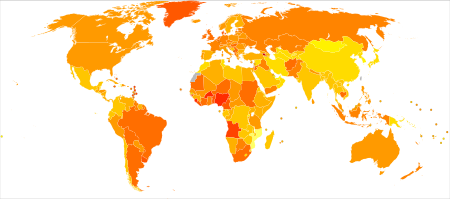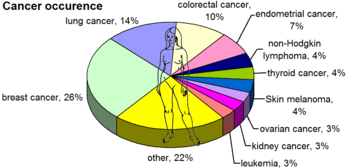| Revision as of 18:29, 7 January 2017 editAnomieBOT (talk | contribs)Bots6,571,198 editsm Substing templates: {{Multicol}}. See User:AnomieBOT/docs/TemplateSubster for info.← Previous edit | Revision as of 20:50, 8 January 2017 edit undoAnomieBOT (talk | contribs)Bots6,571,198 editsm Substing templates: {{Multicol-break}}. See User:AnomieBOT/docs/TemplateSubster for info.Next edit → | ||
| Line 9: | Line 9: | ||
| {{legend|#ffb000|8-10}} | {{legend|#ffb000|8-10}} | ||
| {{legend|#ff9a00|10-12}} | {{legend|#ff9a00|10-12}} | ||
| {{ |
{{Col-break}} | ||
| {{legend|#ff8400|12-14}} | {{legend|#ff8400|12-14}} | ||
| {{legend|#ff6e00|14-16}} | {{legend|#ff6e00|14-16}} | ||
Revision as of 20:50, 8 January 2017

| no data <2 2-4 4-6 6-8 8-10 10-12 | 12-14 14-16 16-18 18-20 20-22 >22 Template:Multicol-end
Worldwide, breast cancer is the most common invasive cancer in women. (The most common form of cancer is non-invasive non-melanoma skin cancer; non-invasive cancers are generally easily cured, cause very few deaths, and are routinely excluded from cancer statistics.) Breast cancer comprises 22.9% of invasive cancers in women and 16% of all female cancers. In 2008, breast cancer caused 458,503 deaths worldwide (13.7% of cancer deaths in women and 6.0% of all cancer deaths for men and women together). Lung cancer, the second most common cause of cancer-related death in women, caused 12.8% of cancer deaths in women (18.2% of all cancer deaths for men and women together). The number of cases worldwide has significantly increased since the 1970s, a phenomenon partly attributed to the modern lifestyles. By age groupBreast cancer is strongly related to age, with only 5% of all breast cancers occurring in women under 40 years old. By regionThe incidence of breast cancer varies greatly around the world: it is lowest in less-developed countries and greatest in the more-developed countries. In the twelve world regions, the annual age-standardized incidence rates per 100,000 women are as follows: in Eastern Asia, 18; South Central Asia, 22; sub-Saharan Africa, 22; South-Eastern Asia, 26; North Africa and Western Asia, 28; South and Central America, 42; Eastern Europe, 49; Southern Europe, 56; Northern Europe, 73; Oceania, 74; Western Europe, 78; and in North America, 90. United States  The lifetime risk for breast cancer in the United States is usually given as about 1 in 8 (12%) of women by age 95, with a 1 in 35 (3%) chance of dying from breast cancer. This calculation assumes that all women live to at least age 95, except for those who die from breast cancer before age 95. Recent work, using real-world numbers, indicate that the actual risk is probably less than half the theoretical risk. The United States has the highest annual incidence rates of breast cancer in the world; 128.6 per 100,000 in whites and 112.6 per 100,000 among African Americans. It is the second-most common cancer (after skin cancer) and the second-most common cause of cancer death (after lung cancer) in women. In 2007, breast cancer was expected to cause 40,910 deaths in the US (7% of cancer deaths; almost 2% of all deaths). This figure includes 450-500 annual deaths among men out of 2000 cancer cases. In the US, both incidence and death rates for breast cancer have been declining in the last few years in Native Americans and Alaskan Natives. Nevertheless, a US study conducted in 2005 indicated that breast cancer remains the most feared disease, even though heart disease is a much more common cause of death among women. Studies suggest that women overestimate their risk of breast cancer. UK Breast cancer is the most common cancer in the UK (around 49,900 women and 350 men were diagnosed with the disease in 2011), and it is the third most common cause of cancer death (around 11,600 women and 75 men died in 2012). Developing countries"Breast cancer in less developed countries, such as those in South America, is a major public health issue. It is a leading cause of cancer-related deaths in women in countries such as Argentina, Uruguay, and Brazil. The expected numbers of new cases and deaths due to breast cancer in South America for the year 2001 are approximately 70,000 and 30,000, respectively." However, because of a lack of funding and resources, treatment is not always available to those suffering with breast cancer. See alsoGeneral: References
|